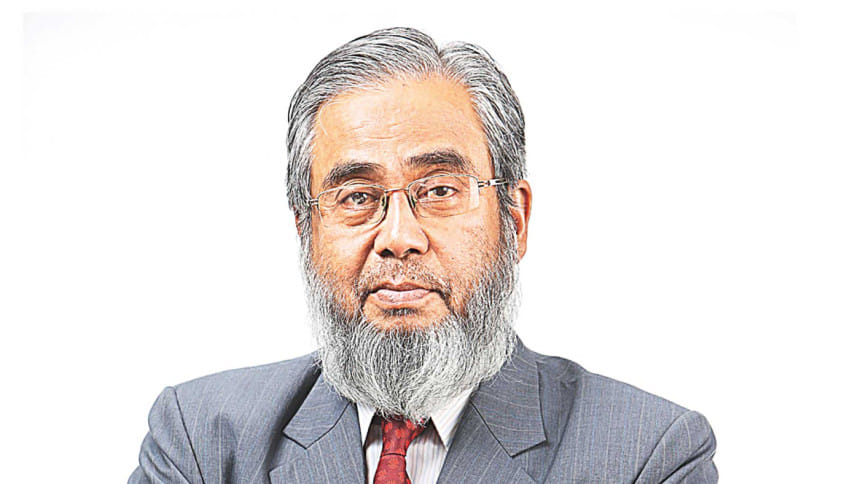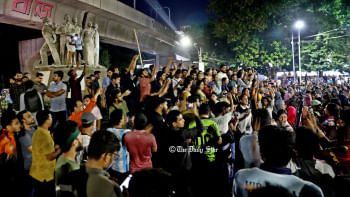“Padma Bridge, a testament to Bangladesh’s confidence and dignity”

Padma Bridge has conquered political, financial and construction challenges, according to Prof Dr M Shamim Z Bosunia, a specialist in structural and concrete design who has been involved with the Padma Multipurpose Bridge project since its early stage. With the government set to officially open the country's largest bridge, Prof Bosunia, head of the project's panel of experts, recalled the challenges faced throughout the journey in an interview with The Daily Star's Priyam Paul.
The Daily Star (TDS): Why was the construction of Padma Bridge a hugely challenging task? How were the challenges overcome?
Prof Bosunia: The laying of the first foundation stone took place in 2001 while a feasibility study was carried out in 2004. Initially, the challenges were of two types. One was the technical challenge involving designing and construction while the political dimension was another big issue. Three sites were short-listed for building the bridge and the current location was among them but the existing Dhaka-Mawa road worked as a key factor in the selection process.
The World Bank was helping us at the time but when the approach roads and other services and buildings were being built, the organisation suddenly came up with news that corruption had been committed. Our honourable prime minister vehemently denied the allegations and said the World Bank had to prove its claims. She then said the government no longer wanted the World Bank's money and it was later proven that no corruption had taken place.
But nonetheless, the work had come to a halt because of the allegation. In 2013, the honourable prime minister asked whether I would be able to start work on the bridge and I answered that if Prof Dr Jamilur Reza Choudhury was with us, then we would be able to do it.
So, we started the task of appointing a contractor. The supervision task was given to the army following a bid and in 2014, we awarded the work for the main bridge and river training. Still though, people pointed to the cost of the bridge, which needed around three lakh tonnes of steel and several billion cubic feet of concrete to build.
At current market prices, the materials would cost Tk 10,000 crore to Tk 12,000 crore while there are many other costs involved. I do not know how the initial estimate was made. The government also had to spend Tk 4,700 crore to acquire land while the value added tax on consulting fees amounted to Tk 3,000 crore.
So, one could not build the bridge for Tk 10,000 crore and costs went up later compared to the initial estimate. Besides, the bridge had to go through political, financial and construction challenges, which we have overcome. Now, we have come to the opening date.
TDS: In terms of construction, is there any unique feature of the Padma Bridge compared to other mega bridges of the world?
Prof Bosunia: Padma is a fast-flowing river, perhaps the second-fastest flowing river after the Amazon and there is too much sedimentation as well. When a pre-feasibility study was being carried out on the Mawa-Janjira site, soil tests were carried out throughout the route and we found that there was weak soil in some parts because of the presence of clay.
We deem clay as weak soil but this clay was very hard, not like the usual clay. Even then, as per engineering sciences, we did not build the piles where there is clay.
There are six piles, or steel foundations, under each pier. We added another pile under the piers for good measure even though foreign engineers said that using even six or seven piles would not make any difference. But we opposed their observation.
When they insisted on load testing the piles, we used a small pipe alongside the main pile to perform grouting. This method has not been used much in the case of bridges in other countries. Putting in place the bearing system in order to help the bridge withstand earthquakes was another challenge. The bearing absorbs horizontal movement of the structure. We have used it even though it has not been used much in other countries as it was only applied in recent years.
TDS: How do you evaluate the role of Bangladeshi engineers in the bridge's construction? How will the project help transfer knowledge and technology regarding the construction of mega-structures?
Prof Bosunia: Around 4,000 engineers worked on the Padma Multipurpose Bridge. Of them, more than 500 were Bangladeshi. When asked about the source of our courage to build the bridge in absence of foreign expertise and funds, we answered that there was nothing to be scared about. We followed the set criteria and in terms of education and knowledge, I don't think there is any dearth in any area.
Many teachers from the Bangladesh University of Engineering and Technology were involved in many large projects in other countries so we onboarded them as well. The most difficult challenge for construction was the lack of equipment. Many of our local contractors have brought in the equipment needed to construct roads, not large-scale bridges.
Now, our contractors and engineers will be able to build bridges like this. Five companies can join their hands together and bring in the necessary equipment. There is no logic why we can't do this. There is enough transfer of technical know-how and technology. The construction of Padma Bridge has given a huge boost to our confidence.
TDS: Why has only one rail line been designed along with the Padma Bridge project?
Prof Bosunia: Many argued that as Bangladesh is increasingly becoming a higher-income country, two rail lines would have been fine. But we have carried out a study keeping in mind the potential traffic scenario in coming decades.
Three trains will be able to cross the rail bridge in an hour, meaning that 72 trains can pass every day. But there are not enough passengers to fill more than five to seven of these trains. Besides, the main bridge would have to be broadened had we added another track, which would have raised costs further. Whenever a road or bridge is designed, we take into account the expected traffic. If there is no traffic, there is no point in widening them.
TDS: Which steps are necessary to keep Padma Bridge safe in terms of maintenance, avoiding collisions with water vessels and climate change?
Prof Bosunia: When the bridge was designed, longevity of 60 to 70 years was kept in mind. We are now saying it will last 100 years because a steel-made bridge is easy to maintain. The Hardinge Bridge is 107 years old while the Bhairab Bridge is close to 100 years and both were built using steel.
It is easy to protect steel-built bridges as the only problem is that they can rust. So, we have to take care to prevent it. The consultant has prepared guidelines on how to protect every structural element of the bridge for the Bangladesh Bridge Authority.
It is like a daily routine. If they follow that, there should not be any problem. So, the maintenance guidelines should be followed strictly. The bridge is made of steel but concrete was used to bear the load. Both reinforced concrete and pre-stressed concrete were used in the bridge, which was designed considering the highest flood levels of the past 100 to 200 years. There is no dearth from any technical point of view. We have tried our best with our knowledge to ensure quality.

 For all latest news, follow The Daily Star's Google News channel.
For all latest news, follow The Daily Star's Google News channel. 



Comments